Adam Yamey's Blog: YAMEY, page 63
January 25, 2024
Separated by millennia but seen together in one glance
ONE OF THE MANY things that fascinates me whenever I visit India is what often appears in one brief glance. It is far from unusual for there to be in one field of vision both something that has been in existence many centuries, or even milliennia, alongside something that is brand new.
Yesterday, I was enjoying lunch in Bangalore’s Kamath Hotel near Commercial Street when I looked up and saw the following reflected in a mirror. A man was sitting working on the restaurant’s computer – probably 21st century technology. Above his head, there were idols depicting Hindu deities, which were in place because the management hoped that their divine influence would benefit the business.
Whereas the computer is but a few years old, the abiding belief in the importance of the Hindu deities in the smooth running of life has been around for much longer than anyone can remember.
January 24, 2024
Exclusion of Indians even after India became independent
WE HAVE STAYED in the guest accommodation at Calcutta’s Tollygunge Club several times. On our most recent visit, I spent a few minutes looking at the boards on which the names of the Club’s past Presidents are listed.
Between the year in which the Club was founded – 1895 – and 1968 – twenty-one years after Indian Independence- all of the Presidents had British surnames.
In 1969, the post was held by Brigadier RB Chopra. His surname is Indian. He was succeeded in 1970 by HA Whittle – someone with a British surname. Mr SP Achary, who was the next President (in 1971) had an Indian surname.
Mr Achary was followed by CJN Will CBE in 1973. Thereafter, most, but not all, of the Presidents had Indian sounding surnames. An exception was the President in 1979, who was AWG Macintyre, CBE.
Seeing all of these Presidents with British surnames holding their positions so long after India became independent got me wondering. Already I knew that even after independence, some private clubs and other institutions in India restricted admission to Europeans and refused entry to all but a very few Indians. I became curious to know when the Tollygunge Club began welcoming Indians as members. The answer is that the colour bar was lifted in 1961. Indians were then admitted as “Associate Members”. They had no voting rights. The first non-white Associate Member was the then Japanese consul. In 1967, the first batch of 30 Associate Members (I.e., Indians) were made Permanent Members. The first Indian President, Brig. Chopra was amongst this batch.
Various factors must have swayed the Club towards admitting Indians. One of these might have been the slowly declining British presence in Calcutta. Another was more serious. Cutting a long story short, in the late 1950s, the West Bengal government, acting to some extent on guidelines from Central government, began to question the future of the elite clubs of India.
The government of West Bengal drew up a plan to construct a housing estate on the extensive grounds of the Tollygunge Club golf course. The clubhouse would have then been converted to some kind of communal amenity. These plans caused great concern to Calcutta’s British community. This plan was aborted. I have heard one explanation of why this happened, but it would be best if I do not reveal it.
Declining Club revenues and increased taxation must have also led to the Club enlarging its membership by accepting Indians as full members. During the very early 1970s, my father-in-law, a senior executive in a large company, was offered membership by the Tollygunge Club. He turned down the offer because he was reluctant to join a club that had refused membership to Indians for so many years after India became independent.
It is fortunate that the Tollygunge Club with its lovely grounds has survived because, although still quite exclusive, it is a wonderful place to relax and make new friends.
January 23, 2024
Almost paperless at the airport in Calcutta
OUR TAXI PULLED up outside the departure section of Calcutta’s huge airport terminal on the 20th of January 2024. We were dismayed to see the extremely long lines of people waiting with trolleys laden with assorted baggage. They were all waiting to pass through the police security check points to enter the terminal.
We soon realised that even if we were to have been at the head of one of these queues, we would not have been able to pass through the checkpoint without having first registered with DijiYatra.
If you have not flown from an Indian airport recently, you will be as puzzled as we were. DijiYatra is an electronic system depending on AI facial recognition to allow passengers to pass the various checkpoints on their way to the ‘plane without having to keep on showing paper documents at each point.
An app exists for DijiYatra, but we did not have this on our telephones. Looking perplexed, an airport official working for our airline, Indigo, led us to some electronic terminals. A man standing by it entered our PNR code, and took pictures of our faces. Following thus we were each handed small flimsy squares of paper bearing our names, flight details and a QR code. We were directed to a policeman standing nearby.
The policeman scanned our DijiYatra paper slips and checked our passports against the faces now recorded in the system. After this, we were sent to one of the checkpoints next to the entrance to the terminal. There was only one person in front of us. After having our small paper slips and our faces scanned, gates opened and we could proceed to the baggage drop-off counters.
At another checkpoint at the entrance to the security checking area, we scanned our DijiYatra slips once again. When the system matched the slip to a scan of our faces, we proceeded into the security control area.
The idea behind DijiYatra is to reduce the use of paper checking and to replace it by facial recognition systems. All well and good, but in our experience the system did rely on keeping two easy-to-lose tiny bits of paper. I guess that had we downloaded the app, the paper slips would not have been required.
What puzzled me were the long queues. Everyone in them had registered for DijiYatra.
January 22, 2024
Words of advice to an early shopper in India
TODAY, MY SHOULDER bag broke suddenly whilst on my way to Calcutta’s New Market – one of my favourite shopping districts. Humayun Place, which leads from Chowringhee to one side of New Market, is lined with pavement vendors. We stopped at one selling bags, and asked to see one that I hoped might be a suitable replacement for the bag whose strap had just broken.
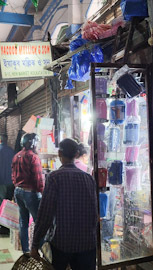 Inside New Market in Calcutta
Inside New Market in Calcutta The bag was ‘ok’ but not ideal. We asked the price, and were quoted 950 rupees (about £9.50). We told the seller that seemed too much for such a bag. We told him that we had paid about 500 for the old bag less than a year ago. Hearing that, he said we could have it for 500, and as he spoke those words, he put it into a plastic carrier bag.
I was still not sure that this was the ideal replacement, and we began to walk away. The seller then offered us the bag for 400, saying that if we bought it would be his ‘bohni’ for the day. Hearing that and feeling that the bag was worth 400, we purchased it.
In India (and Pakistan), the custom of bohni is commonly observed. The bohni is the vendor’s first sale of the day (or at the start of some other defined period of time). Many shopkeepers believe that the bohni establishes the success of his or her business during the rest of the day.
So, one of the risks faced by those who shop soon after the stores or stalls open is they will be made to feel that they ought to buy something in order not to jeopardise the vendor’s success during the rest of the day. For, being the first to enter a shop or halt at a stall without purchasing a bohni is a bad omen for sellers.
Although I am sure most vendors who tell you that by making a purchase you are doing the bohni for the day are bona fide, there must be a few who try to achieve a sale by saying it is the bohni when it is not.
January 21, 2024
Horses and a golf course in Calcutta
HAVE STAYED AT the Tollygunge Club several times, but it was not until yesterday (18th of January 2024) that my friend Prihvi Chaudhury made me aware of an interesting historical object. Near the club’s Shamiana refreshment area and partly hidden by the foliage of a tree, it is a circular metal plate mounted on a tall metal pole. Prithvi told me that it is all that remains of the former Tollygunge Club horse racing track. It was the finishing post.
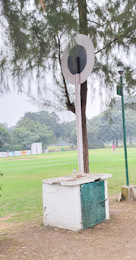
The Tollygunge Club was founded by a Calcutta banker, Sir William Cruikshank. He established the club on land bought from the descendants of Tipu Sultan. The Club was originally founded for British colonialists to enjoy equestrian activities within easy reach of the city. The racecourse was laid out in connection with this.
In addition to the racetrack, much of the extensive grounds of the Club were develope into an 18 hole golf course. This is beautifully landscaped and provides many challenges to the golfers who play there.
The race course was ‘dismantled’ many years ago. However, the Club’s association with horses continues today. On the Club grounds there is an airy, well-maintained stable block, which is currently home to at least 36 horses. We visited the stables today and fed some of the animals with carrots provided by members of the friendly stable staff.
The horses are exercised twice a day either in a special paddock or on some of the footpaths that thread their way through the club’s grounds. Club members can join horse-riding lessons and can hire steeds for taking rides (not gallops) around the Club’s terrain. When taking a ride, the horse and rider are accompanied by a stable hand.
Had Prithvi not pointed out the historic finishing post, I doubt that we would have become aware of the stables for a long time, if at all.
January 20, 2024
Golden dogs on a golf course in southern Calcutta
THE TOLLYGUNGE CLUB in southern Calcutta has a beautiful golf course. Between the greens, bunkers, and other golfing features, there is a large variety of trees, many water features, and a profusion of bushes and flowers. It is a joy to stroll through the grounds, taking care not to get in the way of the golfers and their caddies. As you wander through the terrain, you can spot a variety of birds, the occasional dog, and a few pussy cats. However, the greatest treat is to come across the Golden jackals (Canis aureus) that live on the golf course land.
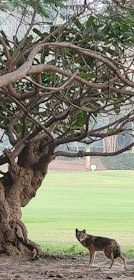
These jackals, usually only seen in the wild, seem quite at home on the golf course. During the day, they lope around or squat, watching the golfers and walkers like myself. Although not tame, they allow humans to approach quite closely before they wander away, but not hurriedly. At night, their howling can be heard if the Club is not holding a noisy social function.
A study by AK Sanyal et Al. (Rec. Zool. Surv. India III, 2010) revealed that when it was published there were 40 to 45 jackals living on the Club grounds. They tend to live some distance away from the Club house and its neighbouring buildings. This is probably because of the tame dogs that hang around close to the Club’s semi-outdoor eating areas. The study discovered that the jackals feed on a wide variety of creatures including insects, birds eggs, rodents, larger animals, and fruits. They are also partial to food produced by humans.
The above-mentioned study revealed that there have been rare attacks on humans, but only by rabid jackals. These incidents have happened in the wild, rather than in the Club’s grounds. And the most common way that the jackals can catch rabies is by being bitten by dogs.
The Tollygunge Club land is about one square kilometre and is home to about 7 families of jackals. In the wild, this number of families would occupy an area of up to three square kilometres. This suggests that the living conditions for jackals in the Club grounds is far better than in the wild.
Every time I have walked on the golf course land, I have seen some of the jackals. When I first saw them, I was wary of them, but now I realise that they have no inclination to interact with me or fellow members of my species. Even though I have seen them plenty of times, I am thrilled whenever I spot one of the Club’s Golden jackals.
January 19, 2024
Hergé, Hitler, and a lifelong friend
A FEW DAYS AGO, I posted a photograph on Facebook. It shows some books displayed on a pavement bookstall in Calcutta’s Park Street. Two of Hergé’s Tintin books were placed next to a copy of Hitler’s “Mein Kampf” (translated into English). The book by Adolf H was placed next to another book – “The Intelligent Investor” by Benjamin Graham. Neither the title nor its author meant anything to me.
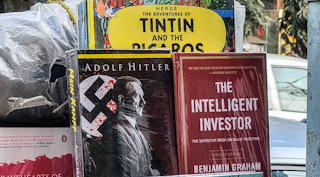
Seeing books by Hergé is not uncommon in India. Nor is it unusual to find copies of Hitler’s book on sale, as I have described in my book “The Hitler Lock and Other Tales of India”.
Soon after I posted the above-mentioned photograph on Facebook, my friend Andrew Sofer, whom I have known since he was born, commented on the photo as follows:
“Grandpa Ben would not be happy about his neighbor.”
I was staggered to read this. The author of “The Intelligent Investor” was Andrew’s grandfather. His book, which was displayed next to Hitler’s was first published in 1949, and still sells well.
Andrew’s father, Cyril, was born in South Africa and was one of my father’s best friends. Cyril was a Don at Queen’s College in Cambridge when he died at a young age. Our family used to visit Cyril and his family at their home in Cambridge regularly during my childhood and early teenage years. Benjamin Graham was the father of Andrew’s mother. I was unaware of Andrew’s connection with Benjamin Graham when I took the photograph of Hergé’s books juxtaposed with “Mein Kampf”.
What puzzles me is whether the close placement of the books by the three authors was random (ie accidental) ,or consciously arranged. Both Hitler and Hergé had fascist tendencies, but not Benjamin Graham. I wonder what was going through the bookseller’s mind when he arranged the books on that stall.
You will not find my book on that bookstall but you can purchase it here: https://www.amazon.co.uk/HITLER-LOCK-OTHER-TALES-INDIA/dp/B0CFM5JNX5/.
January 18, 2024
A young Parsi travelled the world and then fought in WW1
I HAVE JUST FINISHED reading a fascinating book gifted to me by my wife’s cousin. Most of the text is a Parsi’s experiences of fighting for the British during the First World War. Unlike other books about Indian soldiers who fought during that conflict, which deal with statistics and a general overview, this one contains the personal reminiscences of an individual who experienced the battlefronts first-hand.
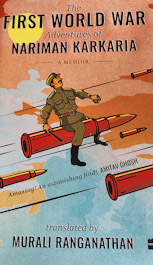
The book is a translation from Gujarati of the memories of a Parsi (a Zoroastrian) from the town of Navsari in Gujarat – Nariman Karkaria (1895-1949). At the age of only 15, Nariman, wishing to see the world, ran away from home, and with hardly any money in his pocket, reached Hong Kong. From there, he slowly travelled through China to Siberia. His impressions of the places he visited are recorded in his often entertaining book.
When WW 1 broke out, Nariman travelled across Russia and through Scandinavia before embarking on a ship to Newcastle in the UK. From there, he reached London, where he enlisted in an English regiment. After detailing the training he received, he describes his journey to the Western Front in France.
In addition to describing the conditions on the battlefields of France, Egypt, Palestine, and Greece, vividly and often in great detail, Nariman portrays his fascination for seeing new places and people in a delightful way. Reading his memoir, I was infected with his enthusiasm for seeing the world.
Near the end of WW, Nariman spent time in Jerusalem, which he describes most interestingly. His accounts of Tbilisi, Istanbul, Baku, and post-WW1 London are fascinating. I was intrigued reading about daily life in Tbilisi and Baku as they were only a short time before the Russian Revolution.
Nariman’s writings portrayed him as a a genial person, whom it would have been fun to have met. His prose is easy to read and never dull. As the translator, Murali Ranganathan, explained in his introduction to the book, what Nariman wrote is a rare account of the travels and wartime experiences of an adventurous young Indian man from Gujarat.
This is a book well worth reading not only because of its unique perspective of WW1 but also its highly agreeable narrative style.
A young Parsi travelled the world and the fought in WW1
I HAVE JUST FINISHED reading a fascinating book gifted to me by my wife’s cousin. Most of the text is a Parsi’s experiences of fighting for the British during the First World War. Unlike other books about Indian soldiers who fought during that conflict, which deal with statistics and a general overview, this one contains the personal reminiscences of an individual who experienced the battlefronts first-hand.

The book is a translation from Gujarati of the memories of a Parsi (a Zoroastrian) from the town of Navsari in Gujarat – Nariman Karkaria (1895-1949). At the age of only 15, Nariman, wishing to see the world, ran away from home, and with hardly any money in his pocket, reached Hong Kong. From there, he slowly travelled through China to Siberia. His impressions of the places he visited are recorded in his often entertaining book.
When WW 1 broke out, Nariman travelled across Russia and through Scandinavia before embarking on a ship to Newcastle in the UK. From there, he reached London, where he enlisted in an English regiment. After detailing the training he received, he describes his journey to the Western Front in France.
In addition to describing the conditions on the battlefields of France, Egypt, Palestine, and Greece, vividly and often in great detail, Nariman portrays his fascination for seeing new places and people in a delightful way. Reading his memoir, I was infected with his enthusiasm for seeing the world.
Near the end of WW, Nariman spent time in Jerusalem, which he describes most interestingly. His accounts of Tbilisi, Istanbul, Baku, and post-WW1 London are fascinating. I was intrigued reading about daily life in Tbilisi and Baku as they were only a short time before the Russian Revolution.
Nariman’s writings portrayed him as a a genial person, whom it would have been fun to have met. His prose is easy to read and never dull. As the translator, Murali Ranganathan, explained in his introduction to the book, what Nariman wrote is a rare account of the travels and wartime experiences of an adventurous young Indian man from Gujarat.
This is a book well worth reading not only because of its unique perspective of WW1 but also its highly agreeable narrative style.
January 17, 2024
Enjoying forbidden food in Calcutta after waiting many years
JHAL MURI IS a Bengali ‘street food’. Mixture of puffed rice, mustard oil, and other things including: chilli, coconut, channa, peanuts, lemon juice, coriander, onion, tomato, sev, chutneys, … and more! You choose your mix.
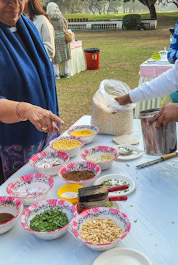 Making jhal muri
Making jhal muri Usually made in the street, it may pose a risk to weak stomachs. My wife’s mother, a medical doctor, forbade her daughter from eating this when it was sold by street vendors. It was sold just outside Loreto House School, where my wife was a pupil. She felt hard done by when she saw her schoolfriends eating this ‘forbidden’ snack.
Today, having yearned for it for many years, she sampled jhal muri at the Tollygunge Club. Sadly, it did not meet her great expectations.



